The insider’s guide to fine wine trends, and the most compelling wines to watch
Wine Lister has released its second annual Wine Leagues, celebrating some of the top-performing wines and producers in today’s new and much-diversified fine wine era. Informed by an in-depth trade survey with leading industry figures, the report provides a 360° view of those regions, producers, and wines that have seen strides in quality, popularity, economic promise, and more in 2021.
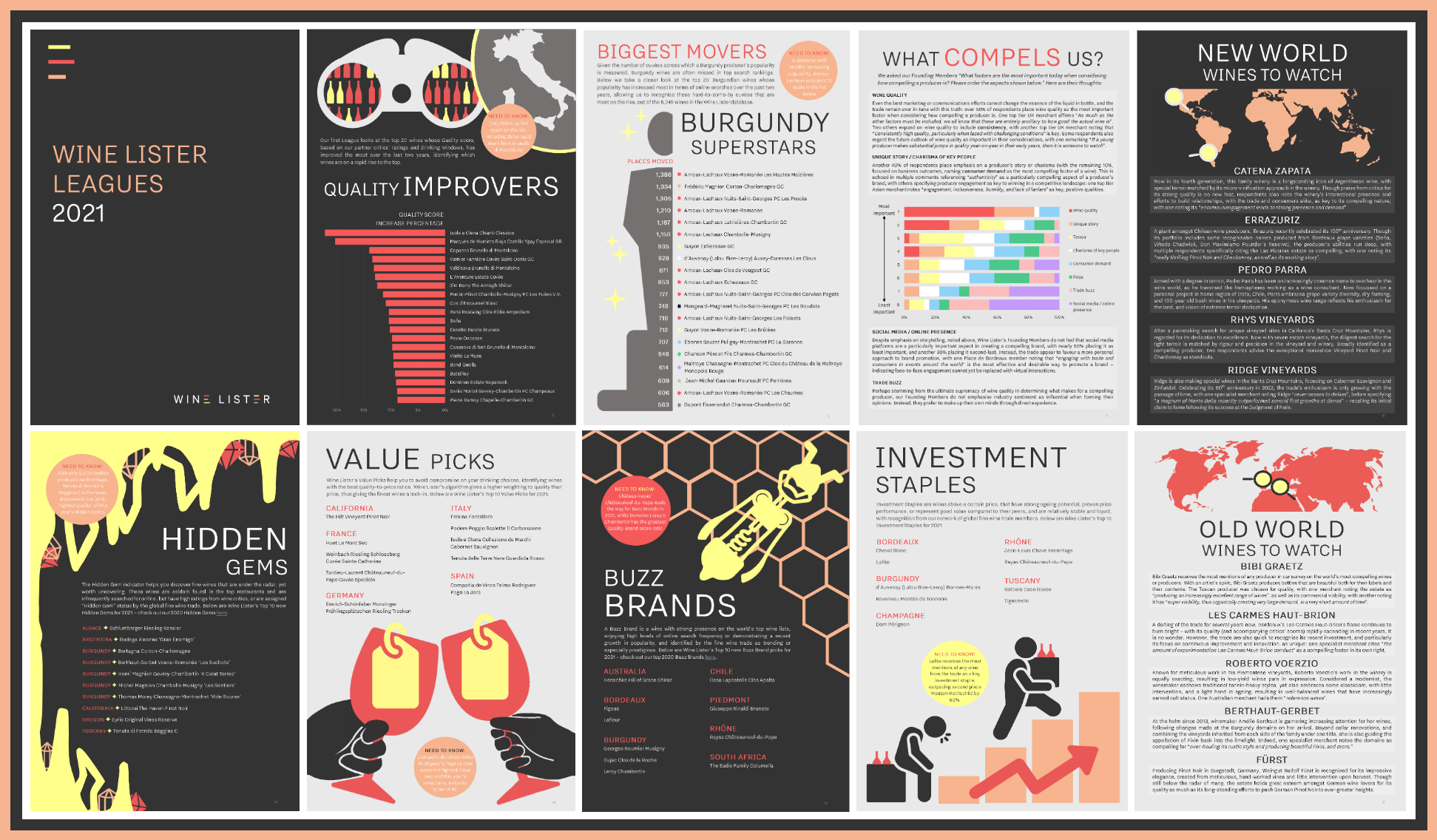
Wine Lister’s annual in-depth survey sees our expert panel of 47 CEOs, MDs, and wine department heads share their insight on some of the fine wines to have on your radar, as we ask them:
“What are the most compelling wines and producers in the market today?”
Respondents singled out 188 wines and producers collectively, that span no less than 20 major regions. Within the list, our team identifies Bibi Graetz, Les Carmes Haut-Brion, Roberto Voerzio, Berthaut-Gerbet, and Fürst as wines to watch in the Old World, whilst calling out the New World wonders of Catena Zapata, Errazuriz, Pedro Parra, Rhys Vineyards, and Ridge Vineyards.
The report also includes rankings across:
- Biggest quality improvers, which show impressive movement from Italy (occupying five places in the list of the top 20 by Quality score progression), with Isole e Olena Chianti Classico leading the pack
- Best search rank movers, wherein Bordeaux represents eight of the top 20 wines whose popularity has increased most in terms of online searches (including Smith Haut Lafitte, Domaine de Chevalier, Figeac, and Léoville Poyferré)
- Burgundy superstars, focusing on popularity movements from the trade’s darling region – Arnoux-Lachaux features 10 times in the list of top 20 Burgundian wines whose online searches have increased the most over the last two years
- Wine Lister’s top-10 recommendations per Wine Lister Indicator; Hidden Gems, Value Picks, Buzz Brands, and Investment Staples in 2021
For the full analysis, download your free copy of Wine Lister’s 2021 Leagues here.
Tales of the 2016 told by Castiglion del Bosco
One of the highest-scoring vintages in recent decades, 2016 has been described as a milestone for Montalcino and its flagship wine, Brunello. Providing the first taste of 2016 Riserva in the UK, WLPR was honoured to accompany Castiglion del Bosco through an early preview of its monumental Riserva Millecento 2016 release (set for January 2022) at London’s Enoteca Turi, joined by a handful of the city’s leading trade figures and fine wine collectors.
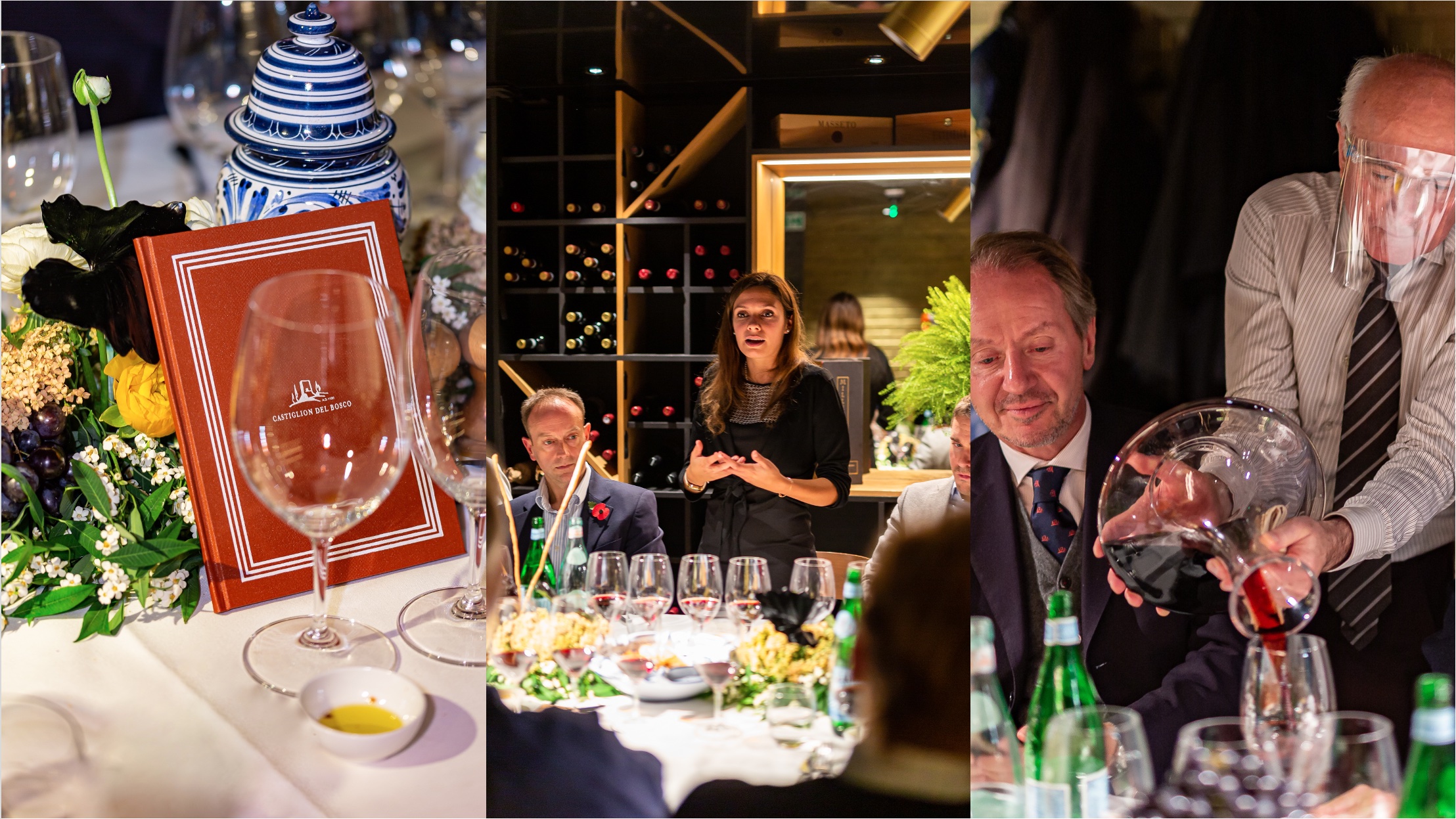 Bespoke menu (left), Castiglion del Bosco’s Marketing Manager, Gemma Grieco talking guests through the line-up (middle), Enoteca Turi owner, Giovanni Turi pouring the wines (right)
Bespoke menu (left), Castiglion del Bosco’s Marketing Manager, Gemma Grieco talking guests through the line-up (middle), Enoteca Turi owner, Giovanni Turi pouring the wines (right)
The 2016 Riserva – some of the best from Brunello?
With big shoes to fill following the release of the highly-praised 2015, the 2016 marks the second great year in a row for Brunello di Montalcino, though very different from its predecessor. Whilst the 2015 growing season was hot and dry, 2016 was slightly cooler, with greater diurnal range during the ripening season. These climatic differences result in the 2015s being more generous in both texture and body, while the successive vintage is pure and elegant, with significant ageing potential.
Having been at the property since its acquisition by Massimo Ferragamo in 2004, Castiglion del Bosco’s winemaker Cecilia Leoneschi describes the 2016 as the estate’s “best ever” Brunello. The mild summer encouraged a long, slow ripening, while good conditions at harvest allowed the estate to “harvest each vineyard at the perfect moment” – resulting in “rich wines with outstanding elegance”.
Cecilia hails the 2016 vintage of Castiglion del Bosco’s Riserva Millecento (so-named due to the property’s original construction in 1100) as having “arrived at our intention”. She refers to creating a wine that reflects the magnificence of the estate’s past, while “representing what we want our future to be”. Finally, she adds that the 2016 relays the estate’s key message with absolute purity, as the growing season allowed her to finetune her senses, and “listen to the land” completely.
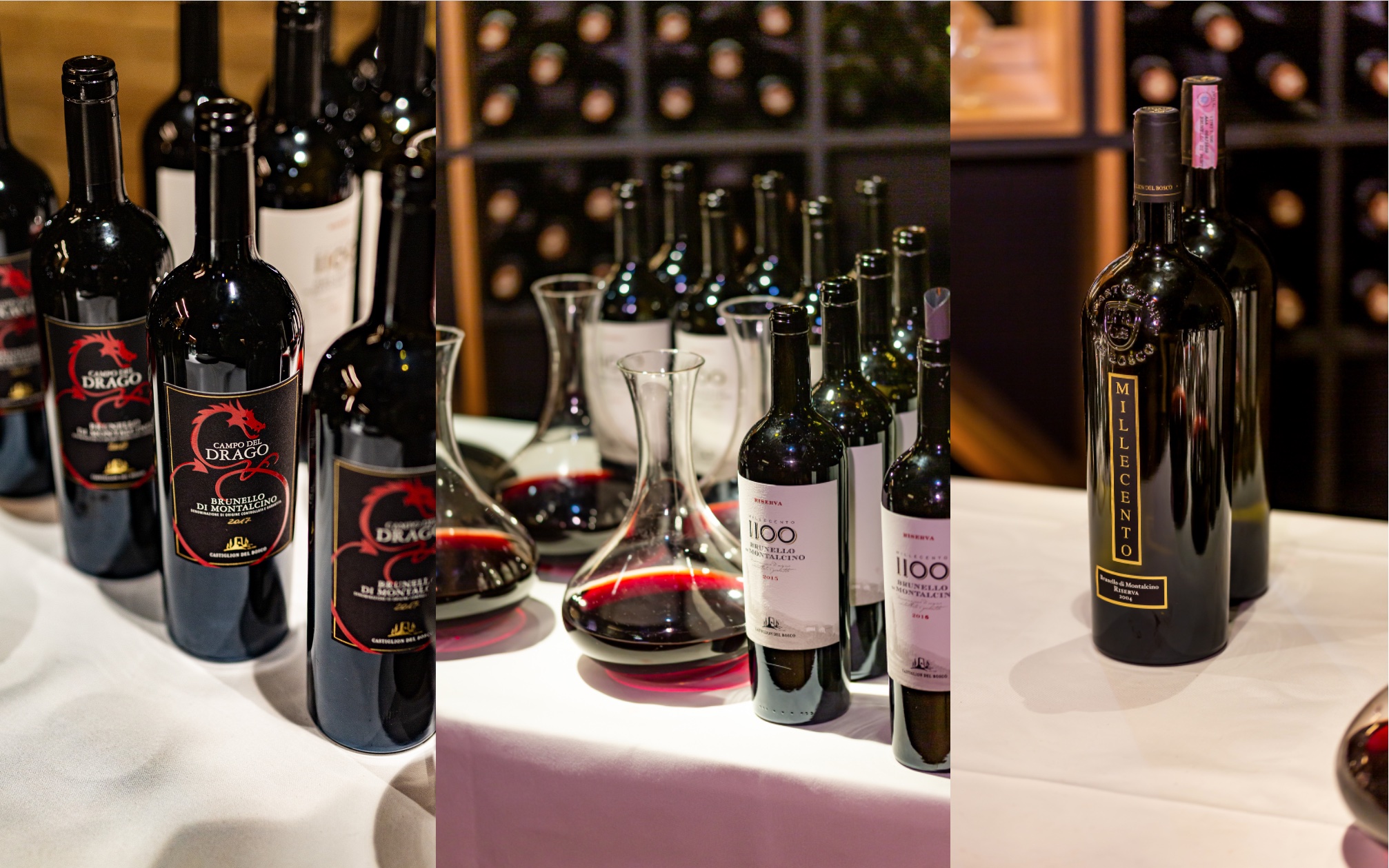 Campo del Drago 2017 (left), Riserva Millecento 2015 and 2016 (middle), and Riserva Millecento 2004 (right)
Campo del Drago 2017 (left), Riserva Millecento 2015 and 2016 (middle), and Riserva Millecento 2004 (right)
Bringing to life the best of Brunello
The Castiglion del Bosco team came to London on Thursday 14th November to tell the tales of the Riserva Millecento 2016 to an audience of 25 industry members and fine wine collectors. Bringing Tuscany to Chelsea, and the estate’s historic past to the present, all guests left with a short storybook, detailing key moments at Castiglion del Bosco that shape the estate’s future, and of course, its wines.
The chosen pouring order of wines, paired with a traditional Tuscan fare from Enoteca Turi’s Head Chef, Massimo Tagliaferri was also symbolic of the changing hands of time, and those traditions maintained – vintages 2004, 2010, 2015, and 2016 we served side-by-side, and tasters were invited to try from 2004 upwards, and back down again.
2004 was the first Riserva made under the current team, while the 2010 was the first to be released under the “Millecento” name. A direct comparison of the 2015 and 2016 – the latest Riserva released, and that which is yet to come – illustrates what Cecilia describes as “two different approaches to quality” in consecutive years.
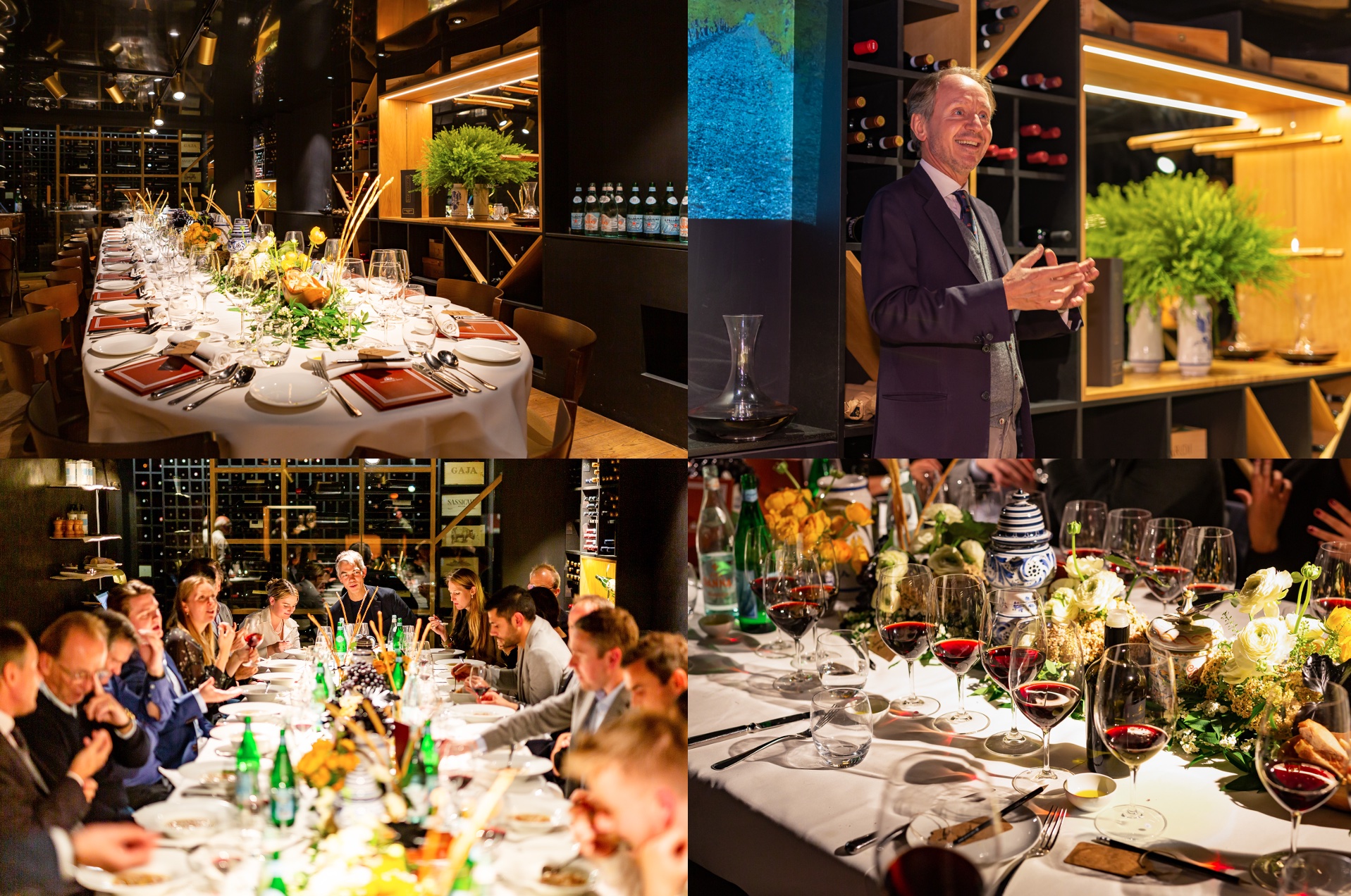 Table designed by Isabelle Buckland (top left), Castiglion del Bosco’s CEO, Simone Pallesi greeting the guests (top right), guests enjoying their aperitivo, Zuppa di Cipolle (bottom left), and the complete Riserva line-up (bottom right)
Table designed by Isabelle Buckland (top left), Castiglion del Bosco’s CEO, Simone Pallesi greeting the guests (top right), guests enjoying their aperitivo, Zuppa di Cipolle (bottom left), and the complete Riserva line-up (bottom right)
Wines tasted: Brunello 2017, Campo del Drago Brunello 2017, Riserva Millecento 2016, Riserva Millecento 2015, Riserva Millecento 2010, and Riserva Millecento 2004 (from Massimo Ferragamo’s private cellar), and a Vin Santo 2014 to finish.
For more information on our organisation of tastings and events, please contact the WLPR team here.
The balancing act
Following our recent report on Bordeaux’s 2021 harvest, Wine Lister now turns to Tuscany to find out more about its 2021 vintage so far, with insight from 10 top producers across the region
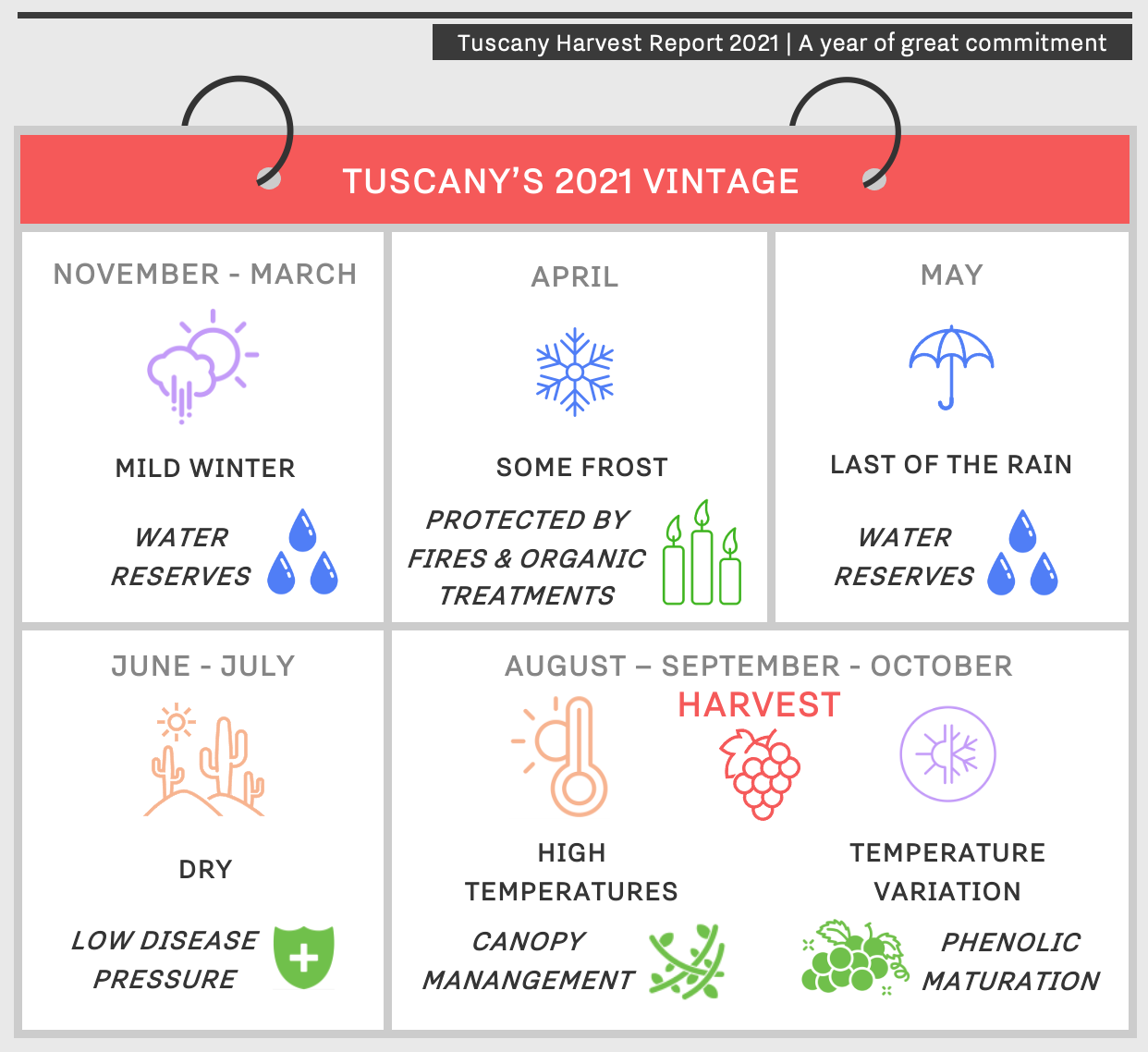
Tuscany’s 2021 growing season has been characterised as a year of climatic extremities, including a mild and rainy winter, the onset of frost in spring, persistent drought in summer, and ending in ideal harvest conditions. In a show of resilience and adaptability, producers were able to reap the benefits of acute weather patterns – with the potential consequences of drought lessened by the groundwater reserves accumulated in winter, and dry conditions reducing disease pressure over the summer.
What can we expect from Tuscany’s 2021 vintage?
Multiple methods to fight frost
- Properties lit fires in the vineyards to circulate warm air and reduce the risk of frost. Owner of IPSUS, Giovanni Mazzei tells us that the technique successfully “increased the temperature up to 2˚C” across the IPSUS vineyards, protecting the vines from damage
- Several producers used organic treatments to improve vine health following the frost, including Argiano, whose Sales Manager, Riccardo Bogi tells us that “brown algae allowed the plants to stabilise and respond as quickly as possible to the loss of sprouts”
- Frost was particularly prevalent in low-lying coastal regions, with Ornellaia’s winemaker, Axel Heinz witnessing “damages limited to a few lower altitude vineyards, without significant impact on production”. Le Macchiole’s Commercial Director, Gianluca Putzolu tells us that the estate also implemented “organic spring fertilization” to combat frost that hit “some, but fortunately very few vineyards”
Water reserves
- Rainfall during winter accumulated important water reserves at both Argiano and Romitorio, encouraging a good state of hydration ahead of the growing season
- Some high-altitude properties also saw snowfall during winter that, when melted, “percolated the soil with water”, according to Romitorio’s owner, Filippo Chia
- Abundant rainfall in May allowed plants to survive the hot summer, with Riccardo confirming that this was “essential” for Argiano’s 2021 vintage, “since after that, there was no rain until the beginning of October”. Similarly, Fèlsina’s owner, Giovanni Poggiali tells us of some “rainy days in June”
Sun and heat exposure
- “The management of the canopy needed to be delicate and precise to avoid sunburns”, explains Avignonesi’s COO and Agronomist, Alessio Gorini, who also explained that the use of high-tech sorting equipment allowed them “to completely remove any berries withered or raisined by the sun”
- Organic treatments were adopted to protect the vines from sun exposure, such as the use of “kaolin” at Tenuta San Guido. General Director, Carlo Paoli explains this to be “a natural substance that we have been using for many years in hot vintages”, which helps to reduce the vines’ susceptibility to scorching
- A broad diurnal range across several high-altitude estates encouraged balance despite the hot summer, with Castiglion del Bosco’s winemaker, Cecilia Leoneschi noting that the difference of more than 10°C between day and night temperatures was a “real blessing”
 Teamwork amongst Tuscan vines: IPSUS (left), Tenuta San Guido (middle), Ornellaia (right)
Teamwork amongst Tuscan vines: IPSUS (left), Tenuta San Guido (middle), Ornellaia (right)
A remarkably healthy vintage
- Lack of rain throughout June and July minimised disease pressure; Filippo confirmed that “from a mould and disease standpoint, it was actually one of the healthiest vintages [Romitorio] has seen”, thanks to the “dry summer”. Giovanni echoes this sentiment for IPSUS, while Gianluca reiterates there were “no particular problems” at Le Macchiole, despite the risk of powdery mildew – a more common problem for the Bolgheri area
Striking when the time was right
- For many estates, harvest timing was essential, with Alessio and the Avignonesi team similarly conscious of “avoiding over-ripening on such concentrated grapes”
- Producers had to be particularly reactive to picking dates, explains Axel – whose 2021 harvest “required great skill” in planning, eventually leading to a “very compact harvest completed in one month, instead of the usual 40 days”. Owner of Tua Rita, Giovanni Frascolla similarly characterised 2021 as a “lightning harvest”
Balanced acidity
- “Powerful dark structure – we normally see this with low acid, but this has high acid” recounts Filippo from Romitorio’s latest tasting of the blend
- First impressions show “bright aromatics and, luckily high acidities to keep everything in balance”, at Ornellaia, with Axel describing a “rich and concentrated” wine, “with soft tannins”
- “Grapes matured in a homogeneous way and with a perfect balance of acidity and PH” explains Carlo at Tenuta San Guido
Working around the clock
Wine Lister catches up with nine top producers from Bordeaux’s Left Bank to find out more about their 2021 harvest, and to hear their early evaluation of the vintage
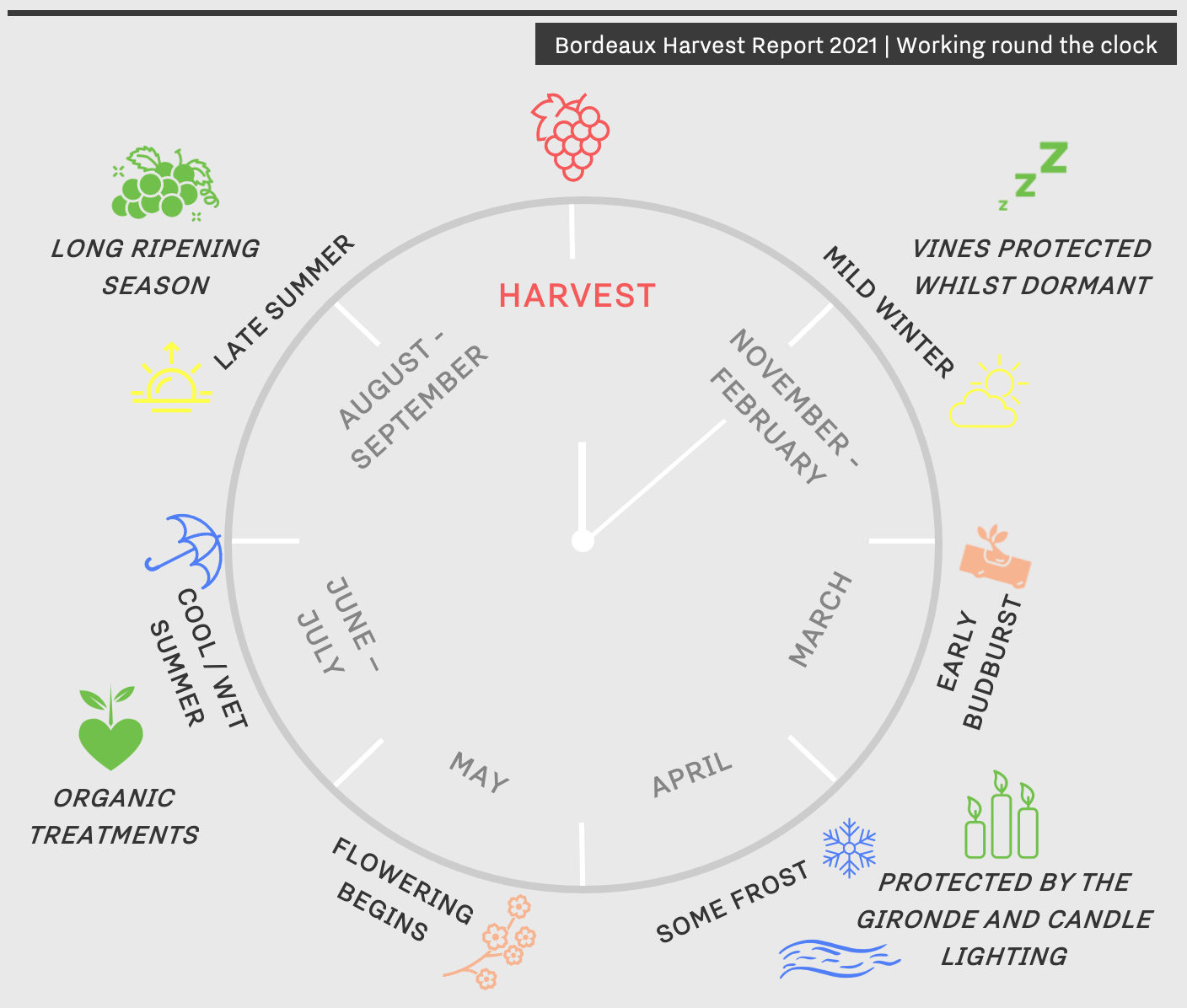
Bordeaux’s 2021 vintage required patience and commitment. Producers worked around the clock to protect their vines – some were threatened by frost, others by disease pressure over the cool and wet summer, but all brought their respective teams together, facing the hand that Mother Nature dealt them with the best experience and techniques the modern wine world has to offer.
What do we know about Bordeaux’s 2021 vintage so far?
Frost protection
- Several producers were protected from the April frost due to their proximity to rivers – just 600m from its banks of the Gironde, d’Issan vineyards escaped damage, according to owner, Emmanuel Cruse. Similarly, Vineyard Manager, Nicolas Dudebout tells us that Malescasse were “naturally shielded” by their privileged positioning near the Garonne
- Other properties were well-equipped to fight the frost proactively, with Smith Haut-Lafitte’s owner Florence Cathiard confirming that a combination of “Valerian decoction (Valeriana officinalis plant root used for its restorative properties), and candles” protected their vines
Organics against disease pressure
- The cool and wet start to summer left some producers vulnerable to disease pressure: Florence told us that Smith Haut-Lafitte reacted to the threat of mildew using “copper mixed with phytotherapy decoctions of horsetail, nettle, wicker, and comfrey”
- “We take the best of both worlds” at Larrivet Haut-Brion, describes Cellar Master, Charlotte Mignon. She explains that the team were “reactive to fighting mildew attacks”, using biocontrol to facilitate the sustainable use of “organic, biodynamic, and conventional solutions [as] necessary”
Late summer ripening
- Late summer sun in August and September created favourable conditions for Merlot, an early-ripening grape variety that is notoriously challenging in hotter temperatures. Cos d’Estournel’s Technical Director, Dominique Arangoïts, found their Merlot to be “remarkably enticing, fruity, and rich with a very noble expression”
- Slower ripening of Cabernet Sauvignon grapes encouraged good phenological maturity: During his last harvest at Lafon-Rochet, Basile Tesseron tells us that, following early pre-harvest berry tastings, the grapes fortunately progressed beautifully in the last few weeks, eventually becoming “more expressive, and well-balanced”
- After a trio of warmer vintages, Charlotte notes that the Cabernets at Larrivet Haut-Brion achieved “perfect ripeness”, thanks to a longer growing season, and sunshine in late-August right up until harvest in October, which gave grapes with “a very good state of health”
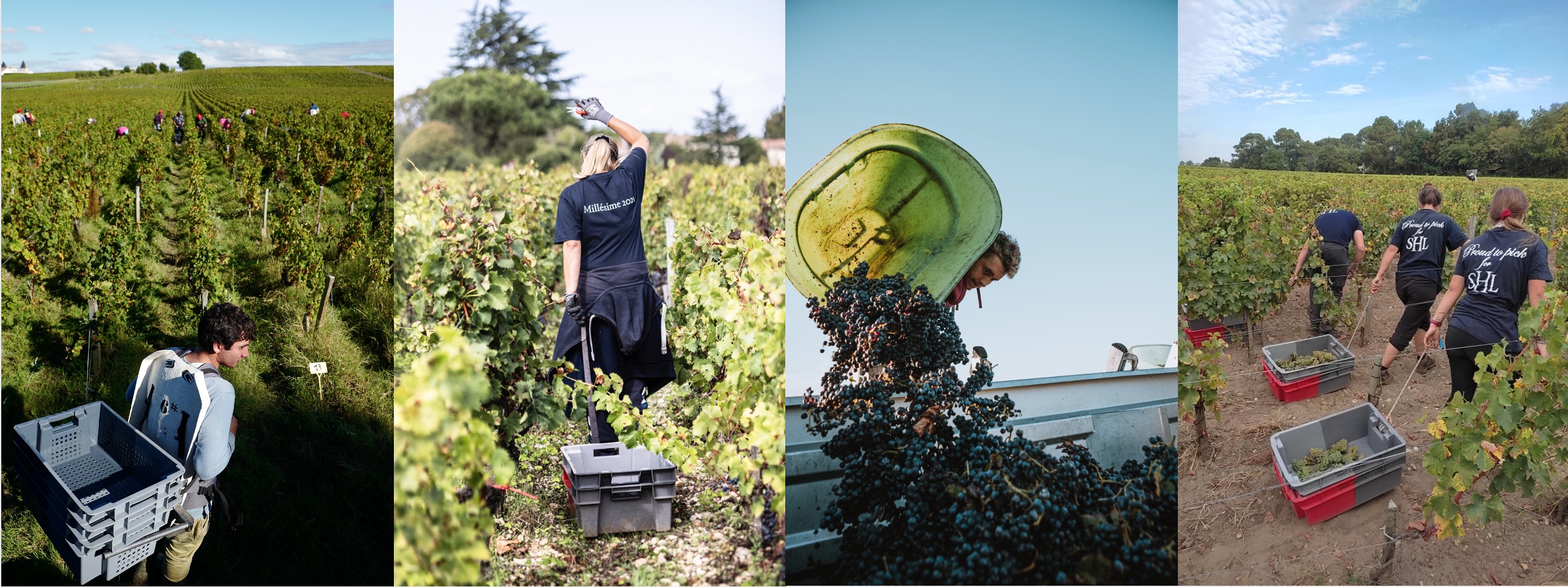 A snapshot of this year’s harvest: Lafon-Rochet (far left), Palmer (middle left), d’Issan (middle right), and Smith Haut-Lafitte (far right)
A snapshot of this year’s harvest: Lafon-Rochet (far left), Palmer (middle left), d’Issan (middle right), and Smith Haut-Lafitte (far right)
Lower alcohol content
- “Low levels of sugar have resulted in a lower alcohol content” in Cos d’Estournel’s Cabernet Sauvignon this year, with Dominique identifying “a magnificent intensity and freshness” and the characteristics of “the most elegant, sophisticated wines”
- “This harvest will be marked by an alcohol-acidity balance, completely different from previous years”, observes Haut-Brion’s Technical Director, Jean-Philippe Masclef. Their Cellar Master, Florence Forgas associates “moderate alcoholic degrees” as being “closer to much older vintages”
- A cooler vintage compared to the previous three resulted in “pure fruit, and a very interesting density” in Palmer’s 2021 grapes, according to Thomas Duroux
Good things to come
- “Merlots are softer than usual and the Cabernets more compact” according to Cantenac Brown’s winemaker José Sanfins, who hopes for an overall blend that is “dense and complete, with fine and elegant tannins”
- Favourable weather during harvest, including “morning temperatures of around 4˚C, preserving freshness across all grape varieties” at d’Issan
- Bordeaux’s whites also boast vibrancy in 2021, with Charlotte noting “freshness and tension” with “aromatic clarity” from Larrivet Haut-Brion’s Sauvignon Blanc and Sémillon grapes
Margaux’s Wine of the Vintage?
Our latest article takes a closer look at one of the final entries in the Place de Bordeaux’s September 2021 Campaign, as we examine Palmer’s re-release from one of Bordeaux’s most challenging recent vintages.
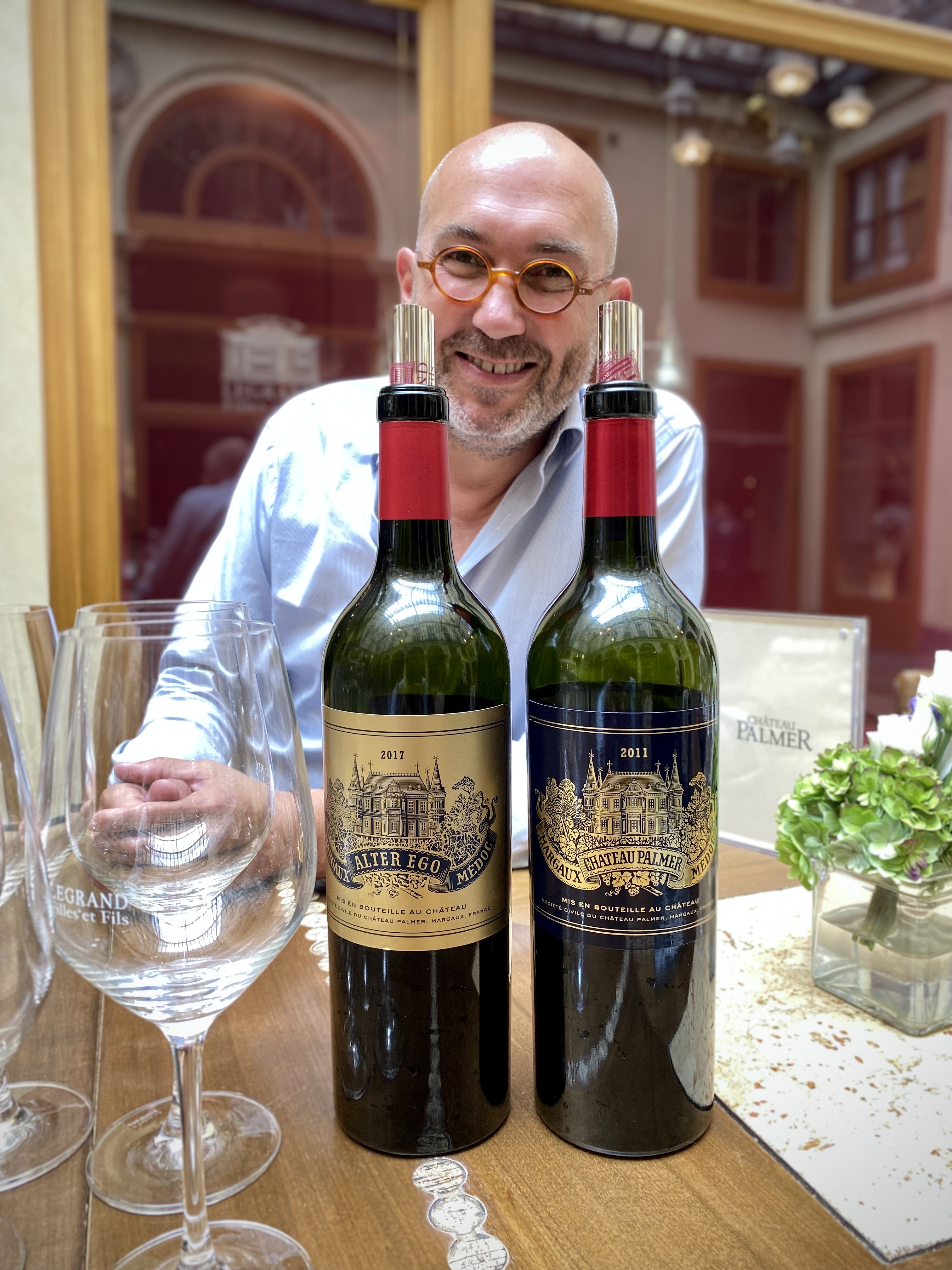 Palmer’s Director, Thomas Duroux tasting Palmer 2011 and Alter Ego 2017 with Wine Lister CEO, Ella Lister
Palmer’s Director, Thomas Duroux tasting Palmer 2011 and Alter Ego 2017 with Wine Lister CEO, Ella Lister
What is the story behind Palmer’s 2011 vintage?
Palmer’s precious secrets
A decade on from production, Thursday 23rd September saw the re-release of Palmer 2011 with a recommended UK onward selling price of £228 per bottle (in-bond). This release represents the second instalment of their ‘10 years on’ series, which presents decade-old ex-château stocks to the market via the Place de Bordeaux. While still releasing Palmer’s latest vintages en primeur, the estate’s Director, Thomas Duroux tells Wine Lister CEO, Ella Lister that withholding stock for ex-château release for 10 years plays tribute to Émile Peynaud’s philosophy that “A great wine needed at latest 10 years of age before it was ready to drink”.
The story of a peculiar vintage
Building momentum amongst merchants and collectors for the release of a notoriously challenging vintage is no mean feat. Duroux’s deft storytelling played on the strengths of Palmer’s historically low yields, reminiscing the events of this curious vintage to encourage interest in the re-release. With a mere 20 hl, the 2011 produced less than half the yield of a normal year, and the even-greater scarcity of re-release availability (approximately 1,000 cases) was surely designed to entice further demand. Several Bordeaux properties suffered at the hands of a significant hailstorm on 4th June 2011, with some falling victim to damage in the crucial berry set period. Although Palmer felt the effects of the growing season, it nonetheless still produced a well-scored wine, matching the average WL score of first growths Margaux, Lafite, and Mouton (93).
Crunch time
Duroux links the quality of their 2011 to the somewhat merciful timing of the hailstorm. Having passed through flowering, the berries were small and able to withstand the storm’s impact, with the damage sustained mostly by the vine’s young shoots. Since the vines compensated by rerouting their energy to grow new shoots, they devoted less energy to fruit development, therefore the harvest yielded a smaller collection of concentrated berries. Such details serve as a good reminder, that the story of a vintage can only paint a partial (and general) picture – digging into the detail of each estate can uncover so much more potential.
Key fine wine releases from Bordeaux and Beyond
As another week of releases draws to a close, we reflect on highlights from the past fortnight, including the latest vintages of signature New and Old World wines, offered through the Place de Bordeaux’s impressive network.
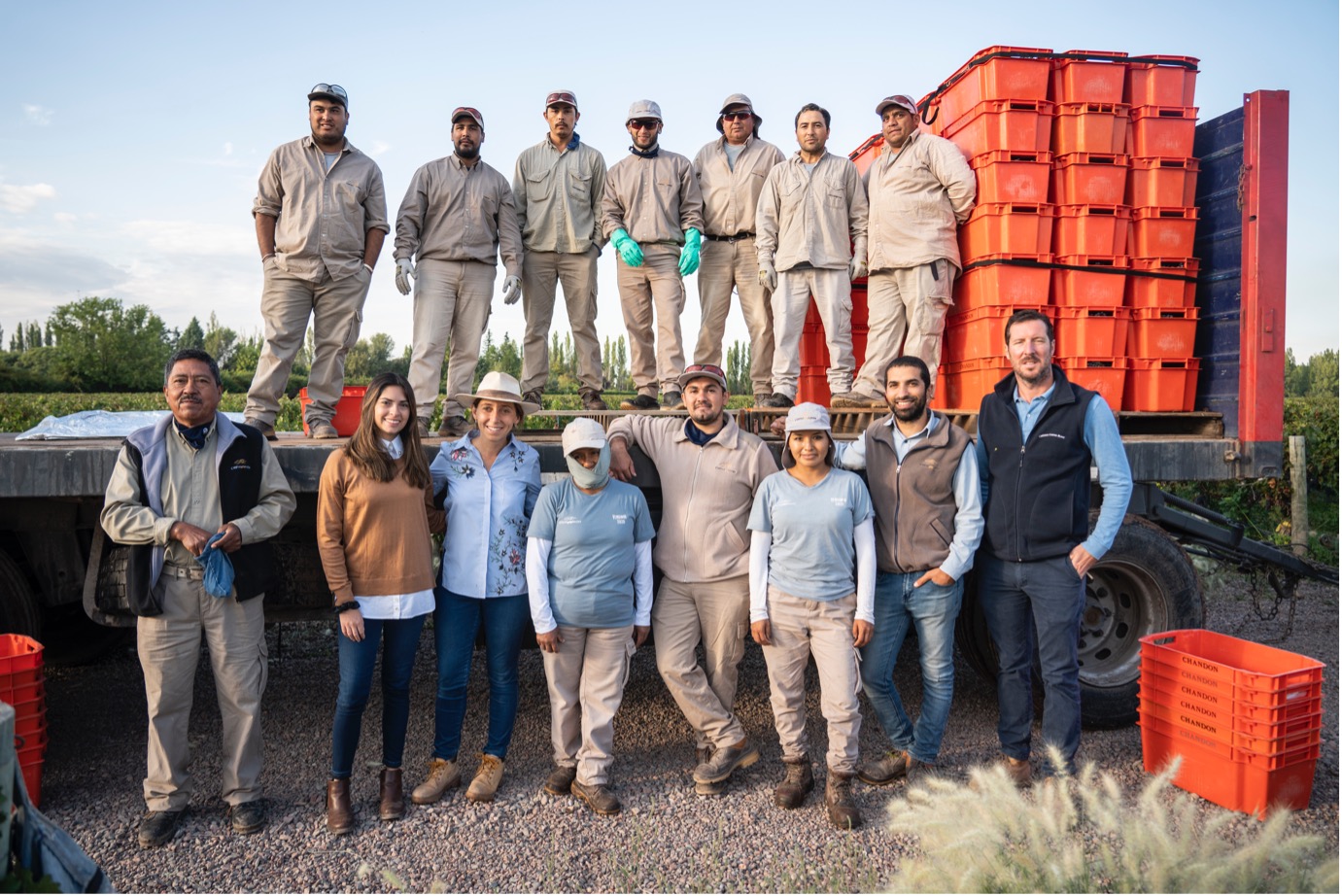 Cheval des Andes’ Technical Director, Gerald Gabillet (bottom right), with the winemaking team
Cheval des Andes’ Technical Director, Gerald Gabillet (bottom right), with the winemaking team
Which wines offer the best investments from the Place de Bordeaux’s September campaign?
As well as a further flurry of releases from the Americas and Tuscany, the past two weeks have also witnessed exciting French entries from the likes of the Rhône Valley, and a re-release of Latour 2005.
California dreaming
One of the top 20 fine wine brands in the world (according to its Wine Lister Pro Brand score), Opus One released its 40th vintage, 2018 last Monday (6th September), at £230 per bottle (in-bond). Wine Lister partner critic, Antonio Galloni (Vinous) gives the latest release a score of 95, describing it as “incredibly elegant and polished, right out of the bottle”.
Napa Valley neighbour, Beaulieu Vineyard’s Georges de Latour Private Reserve 2018 was released on Tuesday (14th September) at £115 per bottle (in-bond). Describing the wine as “sensational”, with notes of “inky red fruit, chocolate, leather, and liquorice”, Galloni gives the latest vintage 98 points – its joint-highest score ever awarded by the critic body. Joseph Phelps’ Insignia 2018 entered the market in quick succession on Tuesday at £163 per bottle (in-bond). Sampled by Wine Lister COO, Chloe Ashton at a recent tasting at 67 Pall Mall (alongside the 2010 and 1998), she found the evolution in complexity, tension, and precision was clear to see.
Monday (13th September) witnessed a triptych of 2018s from Sonoma County’s Vérité, with La Muse, Le Désir, and La Joie released onto the market at £300 per bottle each (in-bond). With the wines representing distinct expressions of the estate through the bespoke blending of different varietals and plots, the Merlot-based La Muse receives a perfect 100-point score from Lisa Perrotti-Brown for Wine Advocate, who calls it “Electrifying!”. Comprising a majority blend of Cabernet Franc, Le Désir gains 97+ and 97 points from Perrotti-Brown and Suckling, respectively. Whilst being Wine Lister CEO, Ella Lister’s favourite amongst the three, the Cabernet Sauvignon-dominant La Joie 2018 secures its highest average critics scores since 2013, inclusive of 98 points from Perrotti-Brown and 99 points from Suckling.
South American sensations
Leading last week’s South American entries, Baron Philippe de Rothschild’s Chilean winery Almaviva released its 2019 vintage on Wednesday (8th September) at £108 per bottle (in-bond). The Wine Lister team found it to show good complexity for its young age, with dense black fruit, exotic spices, and a touch of hay smoke.
Across to Argentina, Cheval des Andes 2018 was released on Thursday (9th September) at £59 per bottle (in-bond). The latest vintage aligns with the estate’s upward quality trajectory in recent years, having been awarded a score of 98 from James Suckling, who describes it as “very long and structured, yet controlled and in balance”.
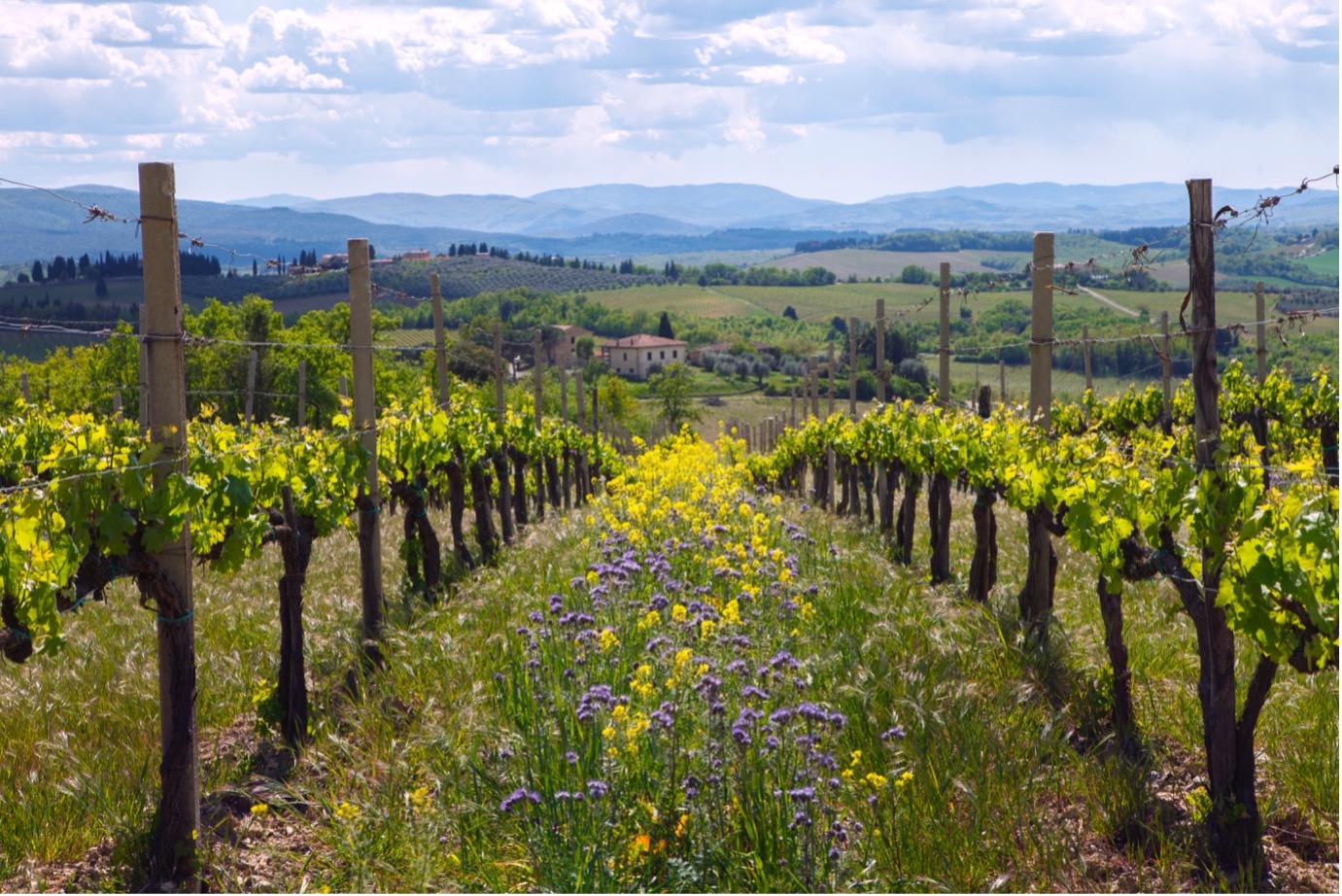 Wildflowers growing in-between Siepi’s Merlot and Sangiovese vines
Wildflowers growing in-between Siepi’s Merlot and Sangiovese vines
A Tuscan triumph
There are now only limited remaining stocks of Masseto 2018, which was released on Tuesday (7th September), starting from £495 per bottle (in-bond). The estate saw one of the rainiest springs in its history, and consequentially faced high levels of disease pressure. Nonetheless, the team at Masseto handled challenges that arose deftly, reflected in Wine Lister’s praise of its dense, layered, and lithe texture.
Now with similarly limited availability at around £208 per bottle (in-bond), Solaia 2018 was released on Thursday (9th September). Galloni awards it a strong score of 98, noting that he “can’t remember ever tasting a young Solaia with this much sheer appeal and balance”. Demand for the 2018 may well be encouraged by the estate’s positive price performance track record, which has seen some of its top-scoring vintages appreciate significantly post-release.
The first of the Tuscan trio to be released last week was Petrolo’s Galatrona 2019, which entered the market on Monday (13th September) at £72 per bottle (in-bond). Gaining a near-perfect score of 99 points from Suckling, he describes it as “muscular, yet agile” – “a unique definition of merlot in Tuscany”. Following in close succession, Castello di Fonterutoli released Siepi 2019 at £68 per bottle (in-bond). The Mazzei family planted its first Merlot grapes in 1980, with Siepi’s varietal blend now comprising equal proportions of Merlot and Sangiovese. The 2019 gains 98 points from Suckling – the joint-highest score awarded by the critic, who praises its “super-structure”, and “finesse with power”. To end Monday’s Tuscan trilogy, Tenuta Sette Ponti’s Orma 2019 was released at £56 per bottle (in-bond). Though Orma is yet to be widely scored by critics, Suckling awards it 97 points, calling it “perhaps the best Orma ever”.
Closing this week’s Italian offerings, Caiarossa 2018 entered the market on Wednesday (15th September) at £35 per bottle (in-bond). Walter Speller for Wine Lister partner critic, JancisRobinson.com, awards it 17+ points, considering it “classy stuff”, “which should become even more compelling with further bottle ageing”.
Back on French soil
Speculated to be the final commercial release of the vintage, Latour released a parcel of its 2005 vintage last Tuesday (7th September), which has since been offered by merchants for around £750 per bottle (in-bond). The 2005 was awarded 100 points by Galloni, who calls it “deep and sensual to the core”, and notes that it is “utterly captivating”. The iconic reputation of both the vintage and the estate is reiterated in this perfect score, which should stimulate interest from serious fine wine collectors.
Racing over to the Rhône, Beaucastel Hommage à Jacques Perrin 2019 was released last Friday (10th September) at around £227 per bottle (in-bond). A cask sample score from Alistair Cooper for JancisRobinson.com signifies quality, awarding its highest score from the critic body since 2007 with 19 points, calling it “One to watch!”.
Click here to sign up to Wine Lister’s newsletter to stay up-to-date with the latest from the Place de Bordeaux’s September campaign.
The best bottle for your budget
Considering the best of white Burgundy MUST BUYs across five different price points, these potential picks gain high WL scores and are all approaching or within their drinking window parameters. Wine Lister’s MUST BUY algorithm produces initial recommendations through considering a wine’s quality and value within its vintage and appellation.
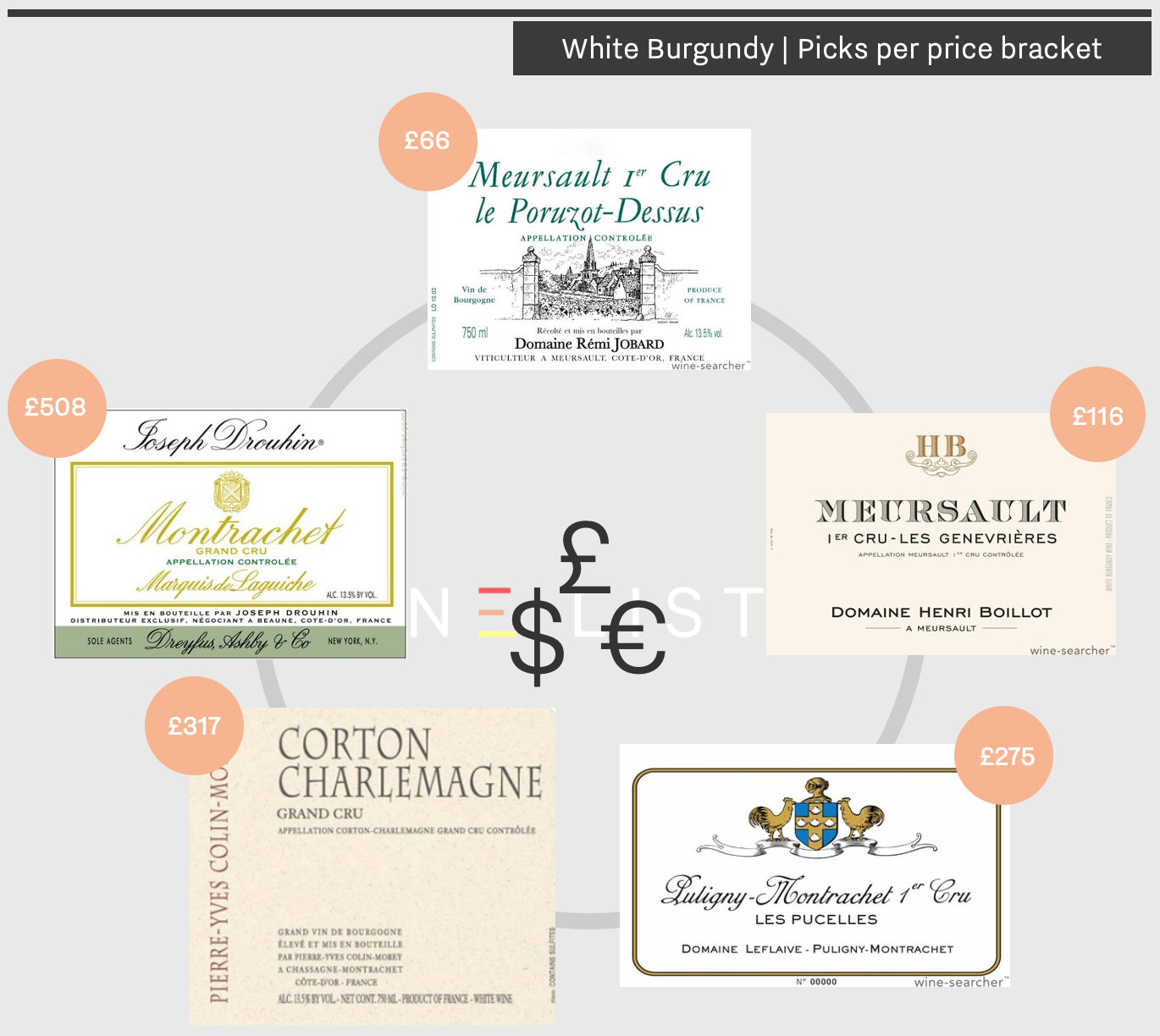 White burgundy MUST BUY picks per price bracket (per bottle, in-bond)
White burgundy MUST BUY picks per price bracket (per bottle, in-bond)
Which are the best white Burgundy wines for my budget?
Notorious for housing wines of high quality with equally high demand, Burgundy has seen some extreme price rises over the last few years. Below we explore top white Burgundies with availability across a range of prices.
With a history of winemaking in his family dating back to the 15th century, Rémi Jobard took over his namesake estate from his father in 1996, and has since overseen many developments. As well as converting to an organic practice in 2008 (and gaining certification in 2011), Rémi introduced cover crop growth across his seven vineyards to encourage the 60+ year old vines to grow deeper to find nutrients. Harbouring a naturally limited yield through cordon-pruning, Rémi Jobard produced just 2,700 bottles of Meursault Le Ponuzot-Dessus in 2015. Despite this, there is still some available of the vintage for under £100, which can be purchased from Lea & Sandeman at around £66 a bottle.
Since taking over the helm of his family property in 2005, fifth-generation wine maker, Henri Boillot has implemented several changes at Domaine Boillot. As well as a focus on sustainable farming methods, including the avoidance of chemicals, and manual harvesting, the team conducts heavy pruning to limit yields, and harvests fruit as late as possible to ensure maximum phenolic maturity. White grapes are crushed gently to avoid bitterness, and fermented in larger barrels than the typical Burgundy “pièce” (350l, vs. 228) to ensure that purity and freshness is unencumbered. Achieving a WL score of 94, the 2016 vintage can be enjoyed at its best for another 10 years, and is available to buy from Fine+Rare at £116 a bottle.
The Leflaive family legacy has been propelled into a modern era, under the founder’s great-grandson and fourth generation leader, Brice de La Morandière since 2015. As part of increased investment into refining its practice, Leflaive introduced a new type of cork in 2016, from natural cork to DIAM (made from broken down natural cork, cleaned with carbon dioxide), which increases the longevity of its bottles. MUST BUY Puligny-Montrachet Les Pucelles 2014 achieves a WL score of 94, and can be found at Corney & Barrow from £275 a bottle.
The son of Burgundy’s infamous Marc Colin (whose domain expands across 30 different appellations in the region), Pierre-Yves established his own project in 2005 from vineyards he inherited from his father. He deviates from traditional Burgundian vinification methods, utilising larger demi-muid barrels (600l) to moderate the influence of oak on the wine and preserve the purity of fruit. Gaining Buzz Brand and Investment Staple status, Pierre-Yves Colin-Morey Corton-Charlemagne 2018 has WL score of 95, and provides a solid bet for top-quality white Burgundy to lay down for the future. It can be sourced from Berry Bros. & Rudd at £317 a bottle.
Produced by négociant house Joseph Drouhin with grapes sourced from vineyards owned by the Laguiche family of the Montrachet Marquis de Laguiche estate, Joseph Drouhin’s Montrachet Marquis de Laguiche 2013 is a MUST BUY at the premium end of white Burgundy offerings. Founded in 1880 by 22-year-old Joseph Drouhin himself, the legacy of its founder’s production has been carried through generations, with the property now under the helm of his four grandchildren, Fréderique, Véronique, Philippe, and Laurent. Receiving a WL score of 96 at around £508 a bottle, the 2013 has 10 more years left of enjoyment. To get your hands on this vintage, you can place a bid for it on the Berry Bros & Rudd online marketplace, BBX.
N.B. All prices are quoted per bottle, in-bond and are correct at the time of publication (19th August 2021).
To keep up to date with our fine wine insights, be sure to subscribe to our free newsletter: https://www.wine-lister.com/subscribe/info
Wine Lister speaks to 10 top sommeliers to find out more about their bottles of choice
 From left to right: Lupo Theones, Victor Petiot, Gareth Ferreira, Beatrice Bessi, and Paul Lo
From left to right: Lupo Theones, Victor Petiot, Gareth Ferreira, Beatrice Bessi, and Paul Lo
What top wines do sommeliers recommend?
Whether offering the perfect food pairing or serving an unforgettable glass, sommeliers are often responsible for creating moments of vinous magic shared by wine lovers far and wide. Our latest blog flips the script, with some of the world’s leading sommeliers sharing with us their most memorable pours, providing the ultimate guide on how to drink like a pro.
Read our blog on your favourite winemakers’ favourite wine for more insight into what the experts are drinking here.
Lupo Theones – Head Sommelier at Hélène Darroze at The Connaught, London
Lupo Theones shares the same sentiment as many of his peers: “it is challenging to choose a single wine when you taste so many great wines as a sommelier”. He nonetheless mentions Egon Müller’s Scharzhofberger Riesling Kabinett 2011 as a wine that “deeply impressed” him, having tasted it soon after moving to London to join The Connaught. Describing a “perfectly balanced” palate that “shows a great acidity and minerality”, Lupo notes that it is a wine you can drink on its own, or paired with the likes of sushi and shellfish, as well as Foie Gras.
Victor Petiot – Wine Director at Caprice at Four Seasons, Hong Kong
Having discovered the vintage just last year, Victor Petiot cites Toro Albalá Don PX 1931 as his favourite wine, due to its “uniqueness” after sleeping in barrel for over 90 years. He explains that it provides “the perfect balance between powerful and well-balanced” with a “sweet and creamy texture yet high acidity”. On the topic of pairing, Victor tells us that the wine prompted the creation of a new dish to be served with it, comprising “a pigeon cooked in a coffee dough with salsify, hazelnut, pan-fried foie gras and pigeon sauce with coffee and a bit of Toro Albalá 1931”.
Gareth Ferreira – Head Sommelier at Core by Clare Smyth, London
Gareth Ferreira recalls being “immediately hooked” on his first real trip to visit the great producers of Burgundy during his early career. He tells us of the first time he tried Jean-Marie Fourrier’s Gevrey-Chambertin Clos Saint-Jacques, which made him question, “how can wine taste this good?”. It has since remained a wine he “looks forward to opening, no matter what the vintage is”, though the first he tasted – 2009 and 2010 – “will always have a special place in [his] heart” and 2002 is one of his favourites in Burgundy.
Beatrice Bessi – Head Sommelier at Chiltern Firehouse, London
“The reason that I became a sommelier is the Nebbiolo grape” exclaims Beatrice Bessi, who fell in love with Barolo in particular over 10 years ago. It is her “never-ending love”, as the region takes a lifetime to know in its entirety (“similar to Burgundy in that respect”, she notes). While citing Bruno Giacosa and Bartolo Mascarello as “traditionalist” producers that she would turn to on special occasions, Beatrice recently “fell in love with the wines of a super modern producer”, Domenico Clerico. In regards to pairing, she tells us that there is “nothing more satisfying” than an amazing glass of Barolo with pizza – there “doesn’t need to be an occasion to have a great glass”.
Paul Lo – Wine Director at Grand Lisboa, Hong Kong
Unable to choose a favourite, Paul Lo instead recalls an exclusive dinner he hosted in May 2014, at which the late chef Joël Robuchon’s menu was paired with 10 wines from the Lisboa cellar hailing from the 1959 vintage. Listing Dom Pérignon Oenothèque, Margaux, Palmer, Latour, Haut-Brion, Lafite, Mouton, La Mission Haut-Brion, Cheval Blanc, and a Steinberger Riesling Trockenbeerenauslese, he tells us that “uncorking the wines in a single event was unforgettable”. He gives particular praise to the Steinberger, noting “so many elements inside – nectar coupled with dried nuts, dry fruits, cigar, caramel, noble spices”, presented with “delicate and perfect acidity”.
 From left to right: Stefan Kobald, Victoria O’Bryan, Julien Sarrasin, Jonathan Charnay, and Pascaline Lepeltier
From left to right: Stefan Kobald, Victoria O’Bryan, Julien Sarrasin, Jonathan Charnay, and Pascaline Lepeltier
Stefan Kobald – Head Sommelier at Pollen Street Social, London
Stefan Kobald tells us that current favourite wine is Philippe Colin Montagny 2016. Having always known of the producer, Stefan discovered this specific cuvée before the first lockdown and has been “hooked ever since”. He describes its “fresh acidity, stunning aromas of ripe apple, citrus notes of lemon peel, and grapefruit”, with a “hint of butter coming from the light oak usage”. Sharing the same philosophy for when he buys wine for the restaurant and himself, he seeks freshness and drinkability, and a wine that invites you back to take another sip – which this wine “definitely does”.
Victoria O’Bryan – Wine Director at Addison Restaurant, California
Narrating her recent encounter with Krug Clos du Mesnil Blanc de Blancs 2002, Victoria O’Bryan tells us that it made her “weak at the knees”. She explains that the wine opened up with surprising ferocity, “like a jolt of electricity giving power and lift to bright citrus tones and a stunning limestone minerality”, with an expression that was “at once creamy and piercing with layers of intensity”. When pairing a wine with “this flair of tension and drama”, Victoria would recommend pouring it alongside caviar or oysters.
Julien Sarrasin – Head Sommelier at Hide, London
“Every wine aficionado would understand the emotion I felt when I first tried this unique wine”, notes Julien Sarrasin, referring the Rhône’s renowned Reynaud family, and specifically a 2004 Rayas Châteauneuf-du-Pape. Now under the influence of the “Rayas effect”, Julien also cites a rosé called Parisy from another Reynaud property, Château des Tours – a blend of Grenache and Cinsault that provided his “most exciting experience” of rosé wine. He describes its “intense bouquet of crushed wild ripe raspberries, jammy strawberries, liquorice stick, and Mediterranean herbs”, which pairs with “intense seafood and fish dishes, as well as meat”.
Jonathan Charnay – Beverage Director at Masa, New York
Echoing Lupo Theones’s choice, Jonathan Charnay tells us that his “absolute favourite wine” is Egon Müller’s Scharzhofberger Riesling, though cites the Auslese as his top wine. He muses on its “great complexity and depth” with “intense aromas of white flowers and honey” that he immediately fell in love with when tasting with Egon Müller during a visit to the winery in 2013. While it is sweet when young, Jonathan points out that it can “age for decades, turning into a delicate elixir” with notes of “apricots, ginger and bergamot”.
Pascaline Lepeltier – formerly Managing Partner at Racines, New York
Pascaline Lepeltier informs us that if she “had to go back to a wine over and over again” it would be Benoit Courault’s Gilbourg – a Chenin Blanc from Anjou in the Loire, where she grew up. “Benoit was one of the first vignerons I met over 15 years ago” she explains, noting that her path was paved by time spent with him in his vineyards in the Coteaux du Layon. Produced with grapes from different plots on schists, Gilbourg is made organically and with minimal intervention – “a real paragon” according to Pascaline. Admiring its “tremendous” ageing potential, she notes its evolution into “the most complete, complex, powerful but ethereal Chenin”.
Explore Wine Lister’s own MUST BUYs for 2021 in our recent blog here.
Keeping it in the family with the best value second wine picks
Further informing your Bordeaux 2020 purchases, we look at the top 20 second wines of the vintage by Wine Lister’s value score. The score is calculated based on the quality to price ratio of a wine and vintage, while still allowing room for higher-priced wines to feature.
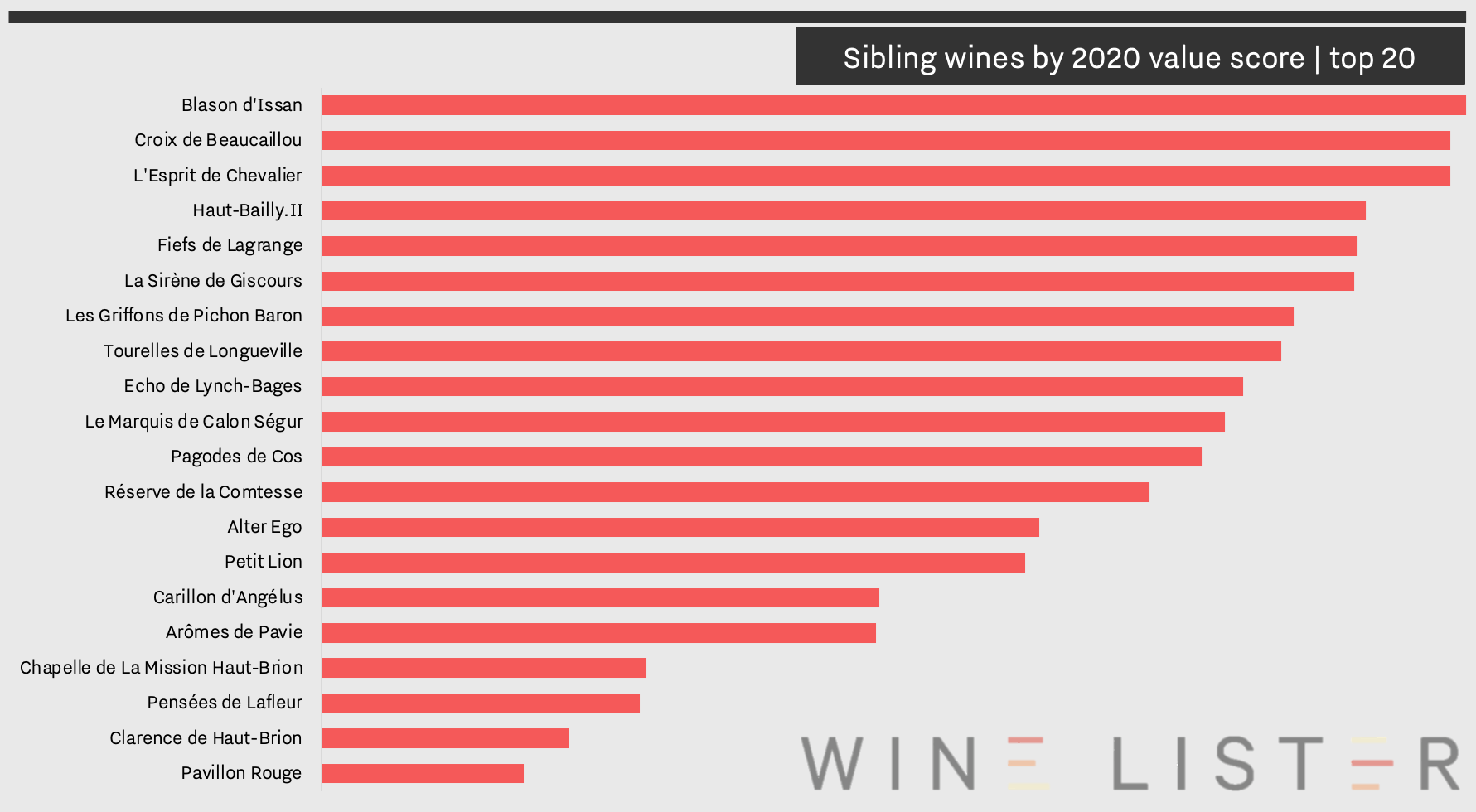 The top 20 leading sibling wines by Wine Lister value score
The top 20 leading sibling wines by Wine Lister value score
Which second wines provide the greatest value?
Often lurking in the shadows of their Grand Vin counterpart, sibling wines offer a high quality, more accessible alternative to Bordeaux’s long-ageing elite. While some are the product of grapes remaining from the Grand Vin, other producers prefer to give a sibling wine its own dedicated plots, often of slightly younger vines. In either case, these wines made at the hands of some of the world’s greatest winemakers should be considered seriously. Below we look at our top picks of sibling wines for value, based on the latest offerings from the Bordeaux 2020 en primeur campaign.
Left Bank legacies
All major Bordeaux appellations across both banks are well-represented amongst the top 20 value picks, with Margaux property, d’Issan achieving the greatest value score for the 2020 vintage. First produced in 1985, Blason d’Issan bears a greater proportion of Merlot than its Grand Vin sibling (57% compared to 39%), but as noted by its maker, Emmanuel Cruse, is still very much a “baby d’Issan”, sporting the château’s perennial style. The second wine of 2020’s wine of the vintage (according to Wine Lister partner critics), Margaux, has been a permanent feature of the estate since the 17th century; christened Pavillon Rogue in 1908, it is 2020’s only top 20 second wine from a First Growth property. Margaux comrade, Giscours, is also represented, by its Sirène de Giscours, which enjoys the same winemaking attention and ageing as the Grand Vin, but with grapes sourced from younger vines. Finally, Margaux majesty, Palmer is featured with Alter Ego. Its 2020 release was well sought-after, particularly after no second wine was produced in 2018.
Pessac-Léognan royalty, Haut-Brion’s Clarence de Haut-Brion ranks among the top 20 sibling wines for value. It is joined by L’Espirit de Chevalier – the red counterpart of Domaine de Chevalier’s sibling series – and Haut-Bailly’s Haut-Bailly II. The latter was renamed (from La Parde de Haut-Bailly) in 2019 to symbolise the second generation of owners, the Wilmers family. Finally, Chapelle de La Mission Haut Brion comes from the same vineyard as the Grand Vin, grown and harvested in the same way, with the introduction of grapes from the older parcels of La Tour Haut-Brion since the 2006 vintage.
Saint-Julien has three properties represented by their second wines, including Croix de Beaucaillou, which ranks in second place. This sibling wine is produced using grapes hailing from its own distinct vineyard, lying to the west of the château. Completing the top five rankings is Fiefs de Lagrange, which bears familiarity to its Grand Vin sibling, but is more suited for earlier drinking. Finally, Léoville Las Cases’ le Petit Lion celebrates its 13th vintage with the release of the 2020, produced from a blend of replanted vines that are now between 15 and 18 years of age.
In neighbouring Saint-Estèphe, Le Marquis de Calon Ségur and Pagodes de Cos occupy 10th and 11th place respectively, with the former taking very different form from their first wine as an alternative interpretation of the Calon terroir. The latter is produced from a separate, dedicated plot of 40-year-old vines.
Completing the Left Bank selection are four Pauillac value picks, of which two hail from the same property. Pichon Baron is the only property to see its two additional wines feature – Les Griffons de Pichon Baron and Tourelles de Longueville. Lynch-Bages’ Echo joins them within the top 10 picks by value score. Finally, Pichon Comtesse’s Réserve de la Comtesse – first sold in 1973 – is a top feature for en primeur 2020. This well-established sibling wine represents between 20% to 50% of Pichon Comtesse’s total production.
Right Bank relatives
One the Right Bank, and particularly in Pomerol, sibling wines have been slower to catch on, simply due to lower production levels per property. Two Saint Emilion Classés A properties nonetheless stand out for sibling value picks– Pavie and Angélus – featuring Arômes de Pavie and Carillon d’Angélus, respectively. The latter is increasingly becoming a “cousin” rather than a sibling, since the property has recently invested heavily in new plots for Carillon alone. Amongst this top pick hoard is Pomerol estate, Pensées de Lafleur, which takes 13th place amongst the top value picks with a limited-production of 500 cases.
Change and adaptation on the banks of Bordeaux
Unpicking the challenges of the 2020 growing season, we talk to seven top Bordeaux producers to understand more about how climate change continues to impact the region’s fine wine industry.
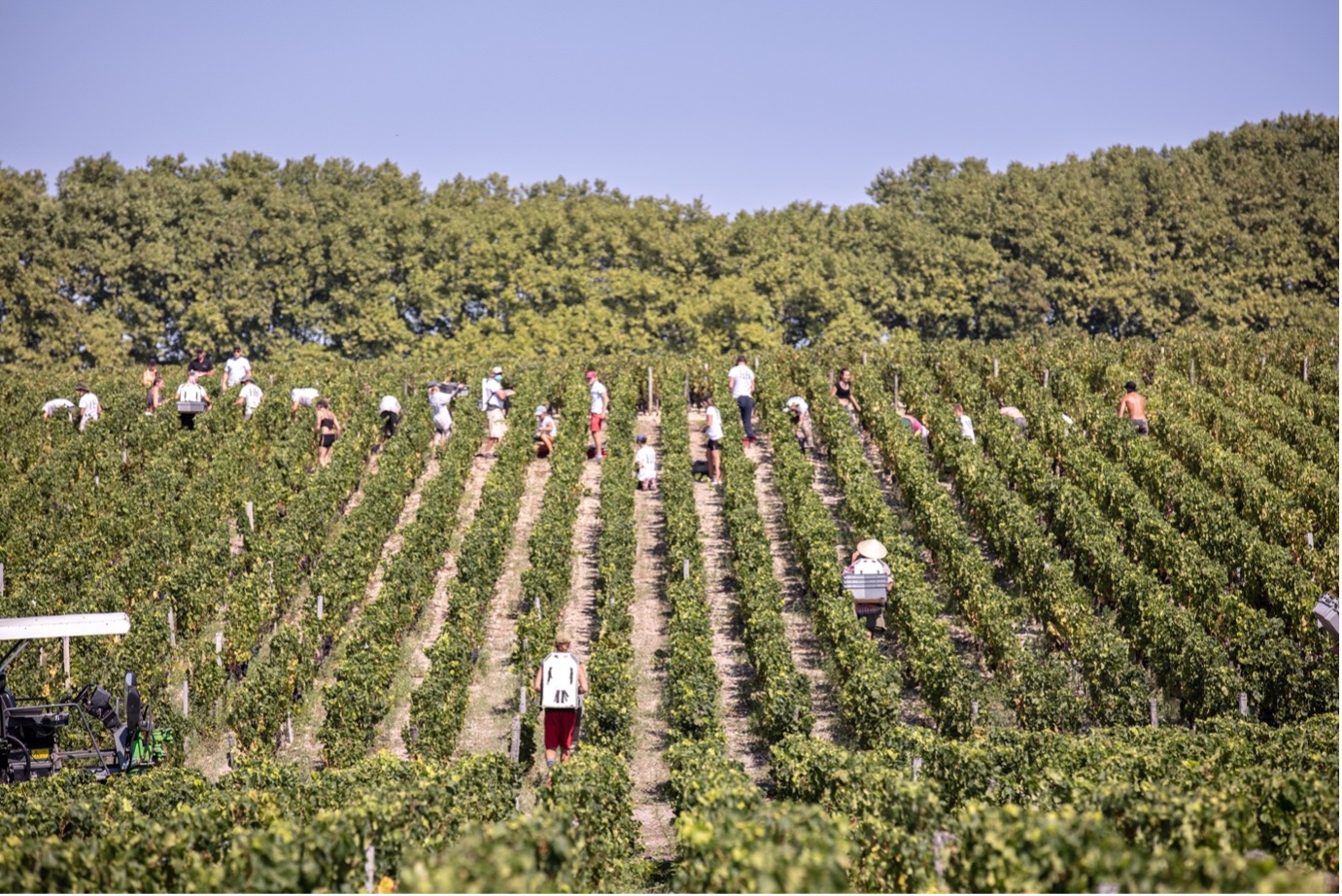 Haut-Bailly harvest under the scorching September sun
Haut-Bailly harvest under the scorching September sun
How is Bordeaux adapting to climate change?
Bordeaux has been no stranger to extreme climatic conditions in recent years, culminating in what some may describe as climatological confusion for many châteaux last year. While witnessing 15% more rainfall between March and September 2020 than its 30-year average for this period, Bordeaux also saw 54 days of excessive drought during the summer. It would appear that now, more than ever, adaptation and innovation are key to the successes of the region’s releases.
Dealing with drought
- Extensive dry spells have become a common phenomenon in Bordeaux, with Margaux’s Business Development Director, Alexis Leven-Mentzelopoulos, sharing with us his concerns that the vines “could end up with wilting” leaves, leading to “a loss in terms of yields but also eventually in terms of quality”. Despite also being one of the wettest years on record, 2020 was no exception with its pattern of heatwaves and ensuing drought.
- Saint-Émilion’s Cheval Blanc experienced its driest vintage since 1959, though Technical Director Pierre-Olivier Clouet explains the humid spring fortunately allowed the vines to accumulate “water and nutrients much needed later in the season”. He elaborates that despite the drought, this allowed vines to “grow calmly and homogenously”.
- Across the Gironde, Haut-Bailly’s Véronique Sanders tells us that “work in the vineyards has evolved enormously”, and that “the fundamental process of pruning has been re-examined” as part of a wider series of viticultural practices that have been changed to adapt to climate change, enabling Haut-Bailly to make the most out of the varied conditions.
Coping with concentration
- Several properties such as Larrivet Haut-Brion saw small and concentrated berries as a result of high temperatures and persistent drought in 2020. The estate’s Cellar Master, Charlotte Mignon tells us that it has had to adapt its winemaking in recent years, opting for punching down versus pumping over in order “to control light and elegant extractions” in such hot years.
- Alexis similarly tells us of Margaux’s recent investment in more highly advanced phenolic analysis equipment, which reports the levels of tannin and pigment in the individually-vinified lots and allows the team to “precisely plan extraction with lower temperatures, fewer and gentler pump-overs, and limited maceration time”.
- Increasingly concentrated grapes have also reduced yields across the region, as told to us by Calon Ségur’s Managing Director, Vincent Millet, whose volumes in 2020 fell to 33hl/ha (down from 40hl/ha in 2019) due to the heat.
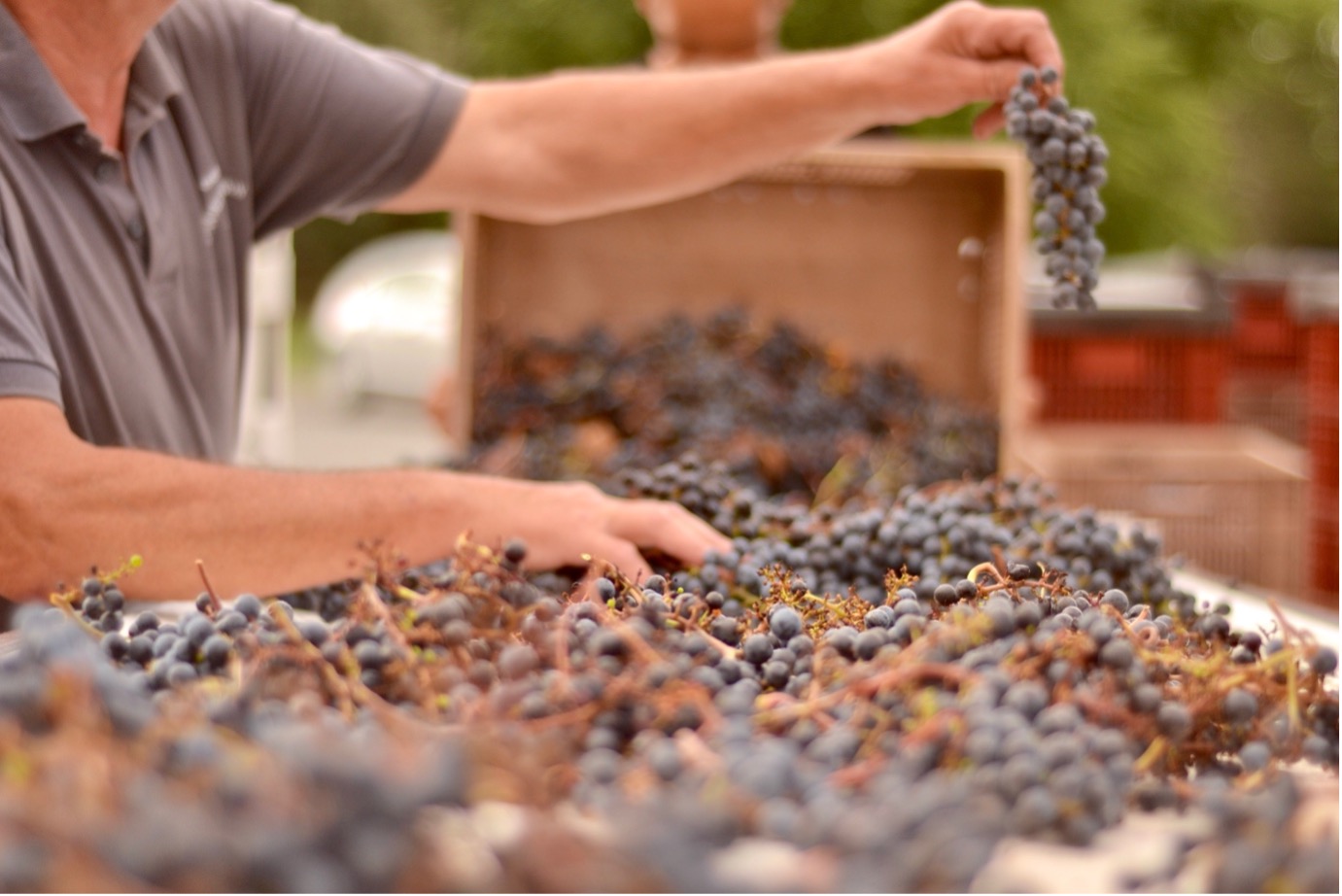 Larrivet Haut-Brion incorporating recently harvested whole bunches into their blend
Larrivet Haut-Brion incorporating recently harvested whole bunches into their blend
A move away from Merlot
- With global warming affecting the evolution of certain grape varieties, Palmer CEO, Thomas Duroux tells us that the “classic complex finish of Merlot” is particularly threatened by rapid ripening induced by hot summers.
- This concern was shared amongst several properties, with Charlotte finding Larrivet Haut-Brion’s Merlot grapes to be heavier, with greater sugar levels and thus a higher alcohol potential. To regain freshness in their Merlot juice, she now “incorporates the whole grape bunch, including the stalk”, to add more structure and tannins. In the long term, the estate is planning to replant more plots to Cabernet Sauvignon due to the varietal’s slower ripening, while Margaux is similarly including “more and more” Cabernet Sauvignon and Cabernet Franc in their blend, and “even thinking of perhaps experimenting with a few rows of Carménère”, to study how it reacts to high temperatures.
- In similar vein, Claire Villars-Lurton of Ferrière remarks on the advantage of less Merlot in the changing climate: “We have prioritised replanting of Cabernet Sauvignon, rather than Merlot, as even young the latter variety is more sensitive to water stress”.
Nourishing nature
- Several of the châteaux we spoke to highlighted their aim of counteracting the effects of climate change by enriching the natural environment and the soil. Thomas emphasises the importance of having a “living soil” in the face of ecological stress, noting that biological compost and plant growth amongst the vines offers “greater stability, root resilience, and nourishment” in increasingly hot and dry years.
- The benefits of a living soil are echoed by Vincent, who tells us that at Calon Ségur they plant grass cover in the vine rows maintains “some moisture in the soil during dry periods”.
- Claire notes that cover crops help to maintain soil biodiversity, but the approach she takes goes beyond this purpose: “we adopt a minimal intervention approach in the vines. We plant cover crops between the rows, that we fold over or cut so as to have a natural mulch – this protects the soil from the damaging effects of strong sunlight, allows the soil to keep a good level of humidity, and means any rain that falls can seep deeper into the subsoils”.
Shading from the sun
- Like several châteaux adapting viticultural practices vintage-by-vintage, Larrivet Haut-Brion withheld leaf removal until later in the 2020 growing season, to shelter grapes from the scorching sun.
- A similar strategy has been adopted at Haut-Bailly, who revise their canopy management every year to reflect the concurrent needs of vines.
- At Calon-Ségur, Vincent explains they are “careful about thinning out the leaves in order to avoid burns”, and are considering “adjusting the height of the trellis” to provide shade from one row to another. Opting for a more permanent solution, Margaux have gone so far as to “change the orientation of the vine rows” in order to “expose each side of the vine to the heat equally and minimize sunscald”.

 Bespoke menu (left), Castiglion del Bosco’s Marketing Manager, Gemma Grieco talking guests through the line-up (middle), Enoteca Turi owner, Giovanni Turi pouring the wines (right)
Bespoke menu (left), Castiglion del Bosco’s Marketing Manager, Gemma Grieco talking guests through the line-up (middle), Enoteca Turi owner, Giovanni Turi pouring the wines (right) Campo del Drago 2017 (left), Riserva Millecento 2015 and 2016 (middle), and Riserva Millecento 2004 (right)
Campo del Drago 2017 (left), Riserva Millecento 2015 and 2016 (middle), and Riserva Millecento 2004 (right) Table designed by Isabelle Buckland (top left), Castiglion del Bosco’s CEO, Simone Pallesi greeting the guests (top right), guests enjoying their aperitivo, Zuppa di Cipolle (bottom left), and the complete Riserva line-up (bottom right)
Table designed by Isabelle Buckland (top left), Castiglion del Bosco’s CEO, Simone Pallesi greeting the guests (top right), guests enjoying their aperitivo, Zuppa di Cipolle (bottom left), and the complete Riserva line-up (bottom right)
 Teamwork amongst Tuscan vines: IPSUS (left), Tenuta San Guido (middle), Ornellaia (right)
Teamwork amongst Tuscan vines: IPSUS (left), Tenuta San Guido (middle), Ornellaia (right)
 A snapshot of this year’s harvest: Lafon-Rochet (far left), Palmer (middle left), d’Issan (middle right), and Smith Haut-Lafitte (far right)
A snapshot of this year’s harvest: Lafon-Rochet (far left), Palmer (middle left), d’Issan (middle right), and Smith Haut-Lafitte (far right) Palmer’s Director, Thomas Duroux tasting
Palmer’s Director, Thomas Duroux tasting 


 From left to right: Lupo Theones, Victor Petiot, Gareth Ferreira, Beatrice Bessi, and Paul Lo
From left to right: Lupo Theones, Victor Petiot, Gareth Ferreira, Beatrice Bessi, and Paul Lo  From left to right: Stefan Kobald, Victoria O’Bryan, Julien Sarrasin, Jonathan Charnay, and Pascaline Lepeltier
From left to right: Stefan Kobald, Victoria O’Bryan, Julien Sarrasin, Jonathan Charnay, and Pascaline Lepeltier The top 20 leading sibling wines by Wine Lister value score
The top 20 leading sibling wines by Wine Lister value score
